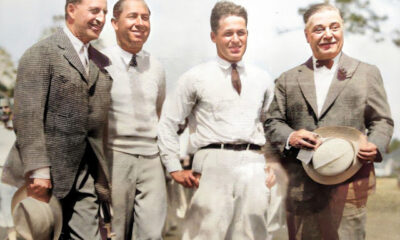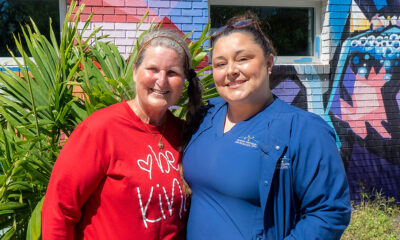Insight
A walk along the Pink Streets reveals a secret garden and a great St. Pete lady

Welcome to the Catalyst’s Community Voices platform. We’ve curated community leaders and thinkers from all parts of our great city to speak on issues that affect us all. Visit our Community Voices page for more details.
After 43 years of living in the southern end of St. Pete, we discovered a park walking distance from our house, one we had no idea was there. It was like a secret garden, pleasant grassy area with a sign that identified it as Pinellas Point Park. It leads from one of the southernmost intersections in the entire county, a charming spot where Armistead Drive S. meets Demens Dr. S.
The adjacent neighborhood is widely known as the Pink Streets. Why? Because the streets are pink and have been for many decades, a deal between the city and the neighborhood to keep the pavement distinctive and oh so F-L-A. It’s a great area with a wonderful variety of housing – of mixed value – and lots of tall shade trees to shelter dog walkers, bike riders, landscapers, kids playing on lawns, parents puttering in their garages.
The Clarks have lived less than a mile north of the Pink Streets in what is called Greater Pinellas Point. We are not just proud Southsiders. We are the proud neighbors of the FAR South Side. Part of our pride comes from a spirit of diversity and tolerance, a middle- and working-class stability that created a street – our street – that has 20 houses, 10 occupied by white families, and 10 by African-American families. We are a street of school teachers, postal workers, police officers, fire chiefs, cafeteria cooks, nurses and lab techs. The house to our left is occupied by an 82-year-old great grandmother of twin boys. To our right is a young couple with two great kids in middle school and high school. Across the span of our three houses we contain four generations.
From our little spot in the city, we could drive to Pass-a-Grille in 15 minutes, downtown St. Pete in 12 minutes, the Tyrone Mall in 18 minutes, and Tampa Airport in a half hour, traffic permitting. We can walk to the great Lake Vista Park in no time, or to Bay Vista Park at the southern end of Fourth Street, or a park at the southern tip of 14th Street that the Clark family has always called “the crab holes.”
From there, visitors can walk across a stretch of green now called Katherine B. Tippetts Park. They can look out through mangroves to a seascape where the Gulf of Mexico flows into Tampa Bay. On the morning of May 9, 1980, coming up on 40 years ago, our family came to this spot to view one of the great disasters of our lifetime: what was left of the original Sunshine Skyway Bridge after it had been struck by a giant freighter. Thirty-five people lost their lives driving over the jagged edge of the bridge into the sea below during a fierce squall.
What an odd juxtaposition to my young daughters with little pails and shovels digging into the muck to harvest hermit crabs popping out of their holes.
During the pandemic, Karen and I have returned to this spot now and then. It’s a safe walk, and we never fail to see a show that Mother Nature has prepared for us. Brown pelicans soar and dive. Ospreys, the great fish hawks of the bird world, fly overhead, wheeling back to their condo nests with a fresh catch for the young. Mockingbirds, ounce for ounce the greatest warriors of the air, attack crows 10 times their size, the noisy black birds smart enough to fly away. It’s not the size of the bird in the fight, but the size of the fight in the bird.
Most people are surprised to learn that the official bird of the State of Florida is not the pelican or flamingo, but the mockingbird. For this we have to thank one of the least appreciated patrons of the City of St. Petersburg, honored now by her name on the Pink Streets Park: Katherine B. Tippetts. Before I learned that the crab holes were now named for her, I discovered her amazing story in an old history of St. Pete.
The Story of St. Petersburg was the work of Karl H. Grismer. My edition dates from 1948. I found it a compelling read for anyone who has spent time in the Sunshine City. This popular history was drawn from the news and photo archives of the St. Petersburg Times and Evening Independent. A main feature is “Who’s Who in St. Petersburg,” a series of profiles of the most important and influential characters who have shaped the city. I counted more than 150 and recognized the many names that now mark our buildings, parks, roads, bridges, schools and neighborhoods.
By virtue of the available photos, all appear to be white, and all but two are men. One of the women is Katherine Bell Tippetts. Her photo shows a handsome woman dressed with a white fur collar, a string of pearls, her hair piled elegantly atop her head. A pair of wireless glasses reveal soft eyes above the hint of a smile.
She arrived in St. Pete in 1902 with her husband William Tippetts, who came here for his health. He would die seven years later. Both had been writers, he a European correspondent for American newspapers, and she a magazine writer and a novelist who wrote under the pen name Jerome Cable. The passing of her husband turned her energy to raising four children and contributing to her Florida home city. In short, Mrs. Tippetts became arguably the most influential woman in St. Petersburg during the first half of the 20th century.
She became a civic activist and a champion of the environment and the natural world, turning her great personal gifts to leading conservation efforts. In 1909 she formed the St. Petersburg chapter of the Audubon Society and became one of its leaders in Florida and beyond.
Grismer writes “Largely as a result of her work, bird sanctuaries were established in Pinellas County, the mockingbird was named as the official state bird of Florida, a Bird Day was proclaimed by the governor of Florida, and laws were passed to protect robins. She also fought for the establishment of the first Fish and Game Commission in Florida.”
She created a national campaign for each state to name an official bird. As a result of her efforts the American Nature Association published a book with pictures of the 50 birds in their natural colors called “Birds of the States.”
In St. Pete she organized the city’s first Boy Scout troop. And it was Mrs. Tippetts who suggested the named “Mirror Lake” to replace the less lyrical “Reservoir Lake.”
Having been recently active in the efforts to get the city to proclaim the brown pelican as its official bird, I see no evidence that Mrs. Tippetts shared my special affection for that comically majestic creature.
Let’s just say that the great lady had to leave a little something for the rest of us to do.
After I read her profile, I was determined to learn more. I did a Google search. What popped up was a map of St. Petersburg with a little red flag marked on the southern tip. The city had named a park after this great woman. And it was walking distance from my house. “OMG,” I thought. “It’s the crab holes!”
See what you learn when you walk around this amazing city?








Paul Haywood
June 16, 2020at2:38 pm
It’s nice that there is a beautiful park in your neighborhood but as the park is being maintained by taxpayers dollars there should be street parking allowed so that ALL citizens of St. Pete could enjoy it. That would fall right in line with the mayors edict of a seamless city for ALL!
Nancy Shannon
May 1, 2020at8:57 pm
Thanks Roy1 This was very interesting ! It is always nice to read of a strong woman who lived life with class and gusto in a time when most men disdained women’s opinions!
Edward Merrick
May 1, 2020at3:16 pm
It is a walkable distance from my residence also, and I walk there often, most recently this morning. However, the park is pretty much a secret because it is effectively reserved for the local residents. The most direct access is the section of 14th Street South that stretches from Pinelllas Point Drive south to the park at the bayfront. The street is two lanes wide in both directions and has a lovely tree-lined divider in the middle, but parking is not allowed on the street for the entire length. There is a spacious turnaround area at the foot of the street where the park begins, wide enough to allow any of our city fire trucks to negotiate without needing to back up, but no parking is allowed there either.